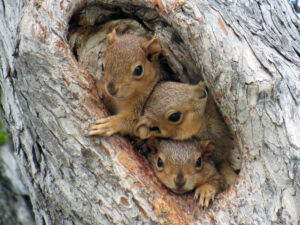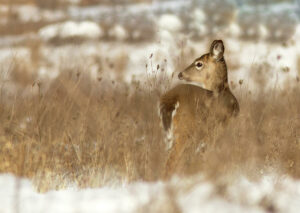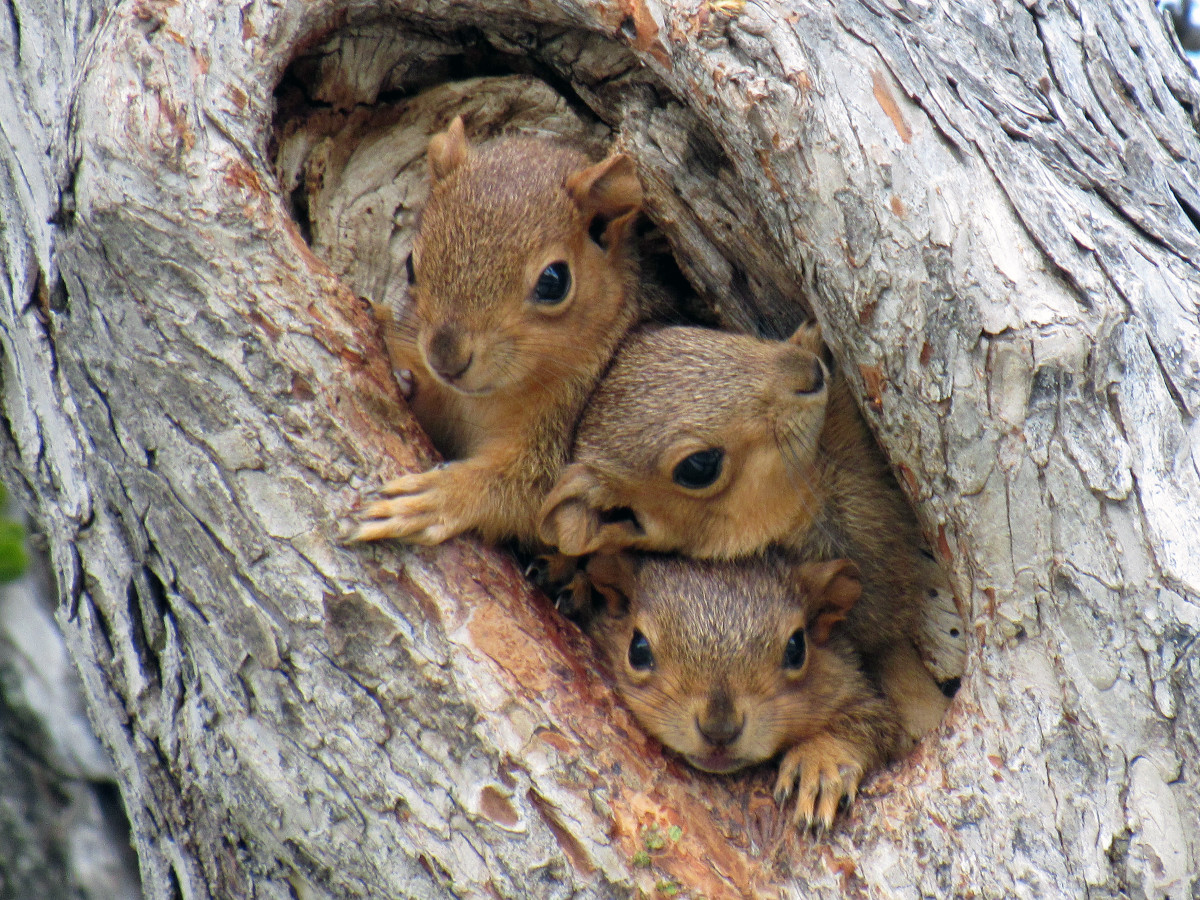by Christy Rybka
Have you ever wondered how animals survive the cold? Many animals have developed strategies to help them adapt to the winter weather, including hibernation, migration, brumation, and more.
Squirrels
In late summer to fall, squirrels prepare for winter by stuffing themselves with as much food as possible. Some squirrels even increase their body fat by up to 50%! When winter comes, this extra supply of fat helps squirrels stay warm and survive the winter when food is scarce.
Each fall, squirrels collect an abundance of nuts from the forest and bury them underground. Although squirrels will travel far to find nuts to bring back to their homes, they are naturally territorial and will only bury nuts within the territory that is theirs. When winter comes, squirrels use their strong sense of smell to detect where the nuts have been buried – even beneath a foot of snow – and retrieve them from underground.
 During extremely cold weather, squirrels stay in the warmth of their dens or nests.
During extremely cold weather, squirrels stay in the warmth of their dens or nests.
While tree squirrels prefer to build nests among the branches of a tree or inside tree cavities, ground squirrels make their homes in underground burrows where they hibernate for the winter. Although tree squirrels do not hibernate like ground squirrels, tree squirrels will sleep for longer periods in winter, only venturing forth during the warmest time of day.
Rabbits
Each fall, rabbits grow a thick winter coat made up of two kinds of fur. The under layer, which is made of soft fur, insulates the rabbit by trapping warm air close to the rabbit’s body, while the upper layer, which is made of coarse fur, protects the under layer from getting cold and wet.
 To stay warm, rabbits also use two kinds of fat! While white fat is used to produce energy, brown fat, which generates heat when it is burned, helps rabbits stay warm while they are out and about in the cold winter weather.
To stay warm, rabbits also use two kinds of fat! While white fat is used to produce energy, brown fat, which generates heat when it is burned, helps rabbits stay warm while they are out and about in the cold winter weather.
Rather than hoarding food in the fall, rabbits adapt their diets each winter by consuming tree bark, twigs, and buds, which provide much needed nutrition when other sources of food are scarce.
Deer
Each fall, deer grow a thick winter coat which helps them stay warm when the temperature decreases. To prepare for winter, deer also eat up to nine pounds of food each day! This extra supply of fat not only helps them survive the winter when food is scarce, but also keeps them warm.
Although deer do not hibernate in the winter, they tend to be less active, which enables them to decrease their metabolism by up to 50%, allowing them to burn less fat.
For shelter, deer will often go to parts of the forest called “deer yards,” where they can find plenty of evergreen trees for coverage. Evergreen trees provide ideal conditions for deer by protecting them from harsh winds and making them less visible to predators.
Foxes
Kentucky has two species of foxes: red foxes and gray foxes. To prepare for winter, they grow thick winter coats.
As the temperature decreases, foxes adapt to the freezing temperatures by naturally redirecting the flow of their blood to the parts of their bodies that are most vulnerable to the cold.
To minimize heat loss through contact with the ground, foxes maintain a lower temperature inside their paws. When it is time for their winter coats to grow, foxes also grow thick fur on their paws, not only to help them retain heat, but also to help them grip icy surfaces!
To stay warm and protect their babies from predators, female foxes usually sleep inside a den. Instead of seeking shelter in the den, male foxes protect the family by sleeping on the ground just outside the den. To stay warm, they curl up in a tight ball and wrap their fluffy tails over their bodies like a blanket!
Birds
Although many birds migrate for the winter, there are many others that stay in our area. Birds that do not fly south for the winter are called resident birds.
 In late summer to fall, resident birds prepare for the cold by stuffing themselves with plenty of high-calorie food and growing warm, fluffy feathers.
In late summer to fall, resident birds prepare for the cold by stuffing themselves with plenty of high-calorie food and growing warm, fluffy feathers.
Fluffing, tucking, and roosting are among some of many other ways that birds protect themselves against the cold winter weather. To read more about how birds survive the winter, follow the link to our previous blog post, “How Birds Stay Warm in the Winter and How to Help.”
Turtles
To survive the winter, turtles swim deep underwater, where they can stay for over 100 days! This process, which is known as brumation, is a state of deep sleep that reptiles experience each winter, similar to hibernation for mammals. This state of deep sleep helps turtles conserve energy by slowing their metabolism and heart rate.
Instead of breathing in oxygen, turtles go through a process called cloacal respiration, in which they absorb oxygen from the water through their blood vessels. When temperatures rise, turtles come up for air and brumation ends.
Frogs and Toads
Frogs also survive the winter by going into brumation. However, not all frogs experience brumation by going underwater.
Although aquatic frogs swim deep underwater when brumation begins, tree frogs prefer to bury themselves under leaf litter, where up to 65% of their body’s water content freezes. This causes elevated blood sugar levels, which then acts as an antifreeze, protecting the tree frog’s body from developing ice crystals. When the tree frog freezes, it stops breathing, it stops moving, and its heart stops beating. When spring returns and the tree frog’s body begins to thaw, its lungs begin to breathe and its heart begins to beat again.
Toads also survive the winter by going into brumation. Before brumation begins, toads dig up to three feet below the frostline, where they remain until winter ends. Their metabolism slows almost completely, stopping their breath, muscle movement, and their heartbeat, until spring returns and their metabolism rises again.
When you visit Creasey Mahan Nature Preserve this winter, look carefully! You just might see a bird fluffing its feathers, a deer hiding in its “deer yard,” or a rabbit munching on some tree bark.
What Squirrels Do In Winter And How They Survive Cold Weather – Backyard Pests
how-to-live-your-best-life-lessons-learned-from-squirrels.jpg (1200×900) (saymedia-content.com)
Where Do Rabbits Go in the Winter: Understanding Their Winter Habits (lionheadrabbitcare.com)
15112932184_9652fe2610_b.jpg (1024×683) (staticflickr.com)
How Do Deer Survive Harsh Winter Weather? | Tufts Now



